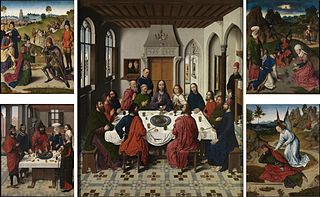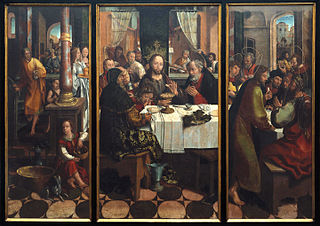 W
WAltarpiece of the Holy Sacrament or Triptych of the Last Supper is a 1464–1468 dated triptych attributed to Dieric Bouts, now reassembled and held at its location of origin at St. Peter's Church, Leuven.
 W
WThe Communion of the Apostles, or Institution of the Eucharist is a painting of the Last Supper by Federico Barocci located at Santa Maria sopra Minerva in Rome. It was commissioned for the family chapel of Pope Clement VIII Aldobrandini and completed between 1603 and 1608.
 W
WAfter Luther's objections to large public religious images had started to fade, Lucas Cranach the Elder, along with his son and workshop began to work on a number of altarpieces of the Last Supper, among other subjects.
 W
WThe Last Supper is a painting by Daniele Crespi.
 W
WThe Sacrament of the Last Supper is a painting by Salvador Dalí. Completed in 1955, after nine months of work, it remains one of his most popular compositions. Since its arrival at the National Gallery of Art in Washington, D.C. in 1955, it replaced Renoir's A Girl with a Watering Can as the most popular piece in the museum.
 W
WThe Last Supper (1445–1450) is a fresco by the Italian Renaissance artist Andrea del Castagno, located in the refectory of the convent of Sant'Apollonia, now the Museo di Cenacolo di Sant'Apollonia, and accessed through a door on Via Ventisette Aprile at the corner with Santa Reparata, in Florence, region of Tuscany. The painting depicts Jesus and the Apostles during the Last Supper, with Judas, unlike all the other apostles, sitting separately on the near side of the table, as is common in depictions of the Last Supper in Christian art.
 W
WLast Supper is a 1568 painting by Greek painter sculptor and architect of the Spanish Renaissance Doménikos Theotokópoulos (1541–1614), most widely known as El Greco.
 W
WThe Last Supper is an altarpiece by Grão Vasco Fernandes, from 1535.
 W
WThe First Supper (1988) is a work of art by Susan Dorothea White, based on Leonardo da Vinci's 1490s painting The Last Supper. White's painting is acrylic on a large wood panel and, in a challenge to the patriarchal concept of thirteen men on one side of a table, shows 13 women from all regions of the world; the woman in the position of Leonardo's Christ figure is an Australian aboriginal wearing a T-shirt with the Australian Aboriginal Flag. One woman seen is in the position of Judas. She dines on a Coca-Cola and a hamburger, while all the other women are seen with a bread roll and glass of water. The painting toured Australia in the Blake Prize for Religious Art exhibition in 1988, where it was ridiculed, before being exhibited in the artist's solo exhibition in Amsterdam, where it featured in the Dutch art journal Kunstbeeld: "The work shows clearly Susan White's thinking about human rights. It should be mentioned here that she sometimes places her many faceted talent at the service of the struggle for human rights".
 W
WThe Institution of the Eucharist or Communion of the Apostles is a 1472-1474 tempera on panel painting by Justus van Gent. Commissioned as an altarpiece, it post-dates its 1460s predella, The Miracle of the Desecrated Host by Paolo Uccello. Both Institution and Miracle are now in the Galleria nazionale delle Marche in Urbino.
 W
WThe Last Supper (1480) is a fresco depicting the Last Supper of Jesus by the Italian Renaissance artist Domenico Ghirlandaio; it is located in the refectory of the Convent of the Ognissanti on Borgo Ognissanti #42 in central Florence, region of Tuscany, Italy. It is one of three Last Supper frescoes painted by Ghirlandaio in Florence, the others being for the Badia di Passignano (1476) and for the Cenacolo di San Marco (1486).
 W
WThe Last Supper is a painting by the Ukrainian painter Mykola Ge (1831-1894), completed in 1863. It is part of the collection of the State Russian Museum in St. Petersburg. The size of the picture is 283 × 382 cm.
 W
WThe conservation-restoration of Leonardo da Vinci's The Last Supper is an ongoing project that has spanned many centuries. Completed in the late 15th century by the Renaissance artist Leonardo da Vinci, the mural is located in the refectory of the Convent of Santa Maria delle Grazie, Milan, Italy. The Last Supper was commissioned by Ludovico Sforza, Duke of Milan in 1495, as part of a series of renovations to the convent with the intention that the location would become the Sforza family mausoleum. Work began on The Last Supper in 1495 and lasted until 1498. The scene is understood to depict the Bible verse John 13:22, showing the reactions of the Twelve Disciples, at the Last Supper, in the moments following Jesus’s announcement that one among them will betray him.
 W
WThe Last Supper is a late 15th-century mural painting by Italian artist Leonardo da Vinci housed by the refectory of the Convent of Santa Maria delle Grazie in Milan, Italy. It is one of the Western world's most recognizable paintings.
 W
WThe Life of Christ is a series of seven paintings in tempera and gold on panel, attributed to Giotto and dating to around 1320–1325. Depicting the Nativity and Passion of Christ, and Pentecost, they are now housed in a number of museums: three are in the Alte Pinakothek in Munich, and the Metropolitan Museum of Art in New York, the Isabella Stewart Gardner Museum in Boston, the Berenson Collection in Settignano and the National Gallery in London all have one each.
 W
WThe Passion of Christ is a set of ten late 15th-century, Gothic religious paintings now displayed in the choir of the Catholic part of Old Saint Peter's Church in Strasbourg, France. The set is classified as a Monument historique by the French Ministry of Culture since 1978.
 W
WThe Last Supper (1493–1496) is a fresco by the Italian Renaissance painter Pietro Perugino, located in the refectory, now museum, of the former Convent of Fuligno located on Via Faenza #42 in Florence, region of Tuscany, Italy.
 W
WThe Last Supper is a painting depicting the Lord's Supper created by Lazzaro Pisani. It is currently the titular altarpiece of the Parish Church in Għasri dedicated to the Institution of the Eucharist.
 W
WThe Last Supper is a fresco by the Italian Renaissance painters Cosimo Rosselli and Biagio d'Antonio, executed in 1481–1482 and located in the Sistine Chapel, Rome.
 W
WThe Last Supper (1630–1631) is an oil painting by Peter Paul Rubens. It was commissioned by Catherine Lescuyer as a commemorative piece for her father. Rubens created it as part of an altarpiece in the Church of St. Rombout (Rumbold) in Mechelen. The painting depicts Jesus and the Apostles during the Last Supper, with Judas dressed in blue turning back towards the viewer and away from the table. Other than Jesus, the most prominent figure is Judas. Judas holds his right hand to his mouth with his eyes avoiding direct contact with the other figures in the painting creating a nervous expression. Jesus is dressed in red and has a yellow halo surrounding his head with his face tilted upwards. Jesus is located centrally in the painting surrounded by his disciples with six on each side, and he holds a loaf of bread with a cup of wine in front of him. Out of all of the figures, he is the most in the light with the figures to the farthest left being the most in shadow. “The scene thus represents a perfect conflation of the theological significance of the Last Supper” meaning the conflation between the blessing of the bread and the wine while still being pivotal in the sense of revealing the betrayal.
 W
WThe Communion of the Apostles is a painting by Italian Renaissance artist Luca Signorelli, dating from around 1512. It is now in the Diocesean Museum of Cortona, Tuscany, Italy.
 W
WLamentation over the Dead Christ is a 1502 tempera on panel painting by Luca Signorelli, painted for the church of Santa Margherita and now in the Diocesan Museum in Cortona. In the left background is the Crucifixion and in the right background the Resurrection.
 W
WThe Last Supper is a painting by the Italian Renaissance artist Jacopo Tintoretto. An oil painting on canvas executed in 1592–1594, it is housed in the Basilica di San Giorgio Maggiore in Venice, Italy.
 W
WThe Feast in the House of Levi or Christ in the House of Levi is a 1573 oil painting by Italian painter Paolo Veronese and one of the largest canvases of the 16th century, measuring 560 cm × 1,309 cm. It is now in the Gallerie dell'Accademia in Venice. It was painted by Veronese for a wall of a Dominican friary called the refectory of the Basilica di Santi Giovanni e Paolo. This painting was intended to be a Last Supper, to replace an earlier work by Titian of this subject destroyed in the fire of 1571. The painting is directly tied to Luke, chapter 5, of the Bible which is clear from the inscription the artist added. The painting shows a banquet taking place in which Christ is the focal point at the center of the image. However, the painting led to an investigation by the Tribunal of the Holy Inquisition in Venice. Veronese was called to answer for irreverence and indecorum, and the serious offense of heresy was mentioned.
 W
WCrucifixion is a 1636-1637 oil on canvas painting by Simon Vouet, with two side-panels showing the Last Supper and the Incredulity of Saint Thomas. It is now in the Museum of Fine Arts of Lyon.